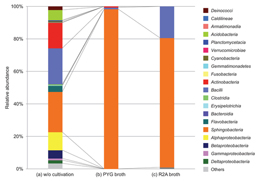Research Abstract
黄砂現象にともなう細菌の地球規模での移動
Global dispersion of bacterial cells on Asian dust
2012年7月23日 Scientific Reports 2 : 525 doi: 10.1038/srep00525

大気現象による細菌の長距離移動は、細菌に固有種が少ないことを裏付けるものとして、微生物生態学において重要なトピックとなっている。長距離移動した細菌の一部は、飛来先の環境に適応し、既存の生態系に影響を与えると考えられる。風送ダストが微生物の運搬者となっていることは知られているが、その理解を深めるには、さらなる研究の進展が必要である。本論文では、黄砂により細菌が地球規模で移動している可能性を示した。我々は、黄砂粒子に微生物が付着していることを、バイオイメージングで直接的に示した。黄砂とともに飛来する細菌の数は、105個/m3から黄砂現象が収束するにしたがって103個/m3未満に低下した。さらに、黄砂粒子上の細菌の16S rRNA遺伝子の配列解析により、系統分類学的に多様な細菌が同定され、またその一部は増殖能を保持していた。今回の結果により、多様な細菌が黄砂粒子に付着し、黄砂現象とともに長距離を移動している可能性があること、さらに飛来先の生態系における細菌群集の多様性に寄与しうることが裏付けられた。
山口 進康1, 一條 知昭1, 迫谷 有希子2, 馬場 貴志1 & 那須 正夫1
- 大阪大学大学院 薬学研究科
- 大阪大谷大学 薬学部
The atmospheric dispersion of bacteria over long distances is an important facet of microbial ecology. Certain groups of dispersed bacteria can adapt to their new location and affect established ecosystems. Aeolian dust particles are known to be carriers of microbes but further research is needed to expand our understanding of this field of microbiology. Here we showed the potential of aeolian dust to global migration of bacterial cells. We demonstrated the presence of microbial cells on dust particles directly by bio-imaging. Bacterial abundance on dust particles declined from 105 to less than 103 cells/m3 as the dust event subsided. Taxonomically diverse bacteria were identified by 16S rRNA gene sequencing and some of these bacteria retained growth potential. Our results confirm that bacteria can attach to aeolian dust particles and they have the potential to migrate globally during dust events and thus can contribute to the diversity of downwind ecosystems.

